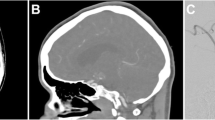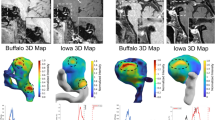Abstract
This chapter will review the role of noninvasive imaging, such as CT angiography and MR angiography, in the management of intracranial aneurysms. In addition, we will also review some of the new advanced imaging techniques that are being used to image intracranial aneurysms.
Access this chapter
Tax calculation will be finalised at checkout
Purchases are for personal use only
Similar content being viewed by others
References
Thompson BG, Brown RD Jr, Amin-Hanjani S, Broderick JP, Cockroft KM, Connolly ES Jr et al (2015) Guidelines for the management of patients with unruptured intracranial aneurysms: a guideline for healthcare professionals from the American Heart Association/American Stroke Association. Stroke 46(8):2368–2400
Connolly ES Jr, Rabinstein AA, Carhuapoma JR, Derdeyn CP, Dion J, Higashida RT et al (2012) Guidelines for the management of aneurysmal subarachnoid hemorrhage: a guideline for healthcare professionals from the American Heart Association/American Stroke Association. Stroke 43(6):1711–1737
Hacein-Bey L, Provenzale JM (2011) Current imaging assessment and treatment of intracranial aneurysms. AJR Am J Roentgenol 196(1):32–44
Ansari SA, Rath TJ, Gandhi D (2011) Reversible cerebral vasoconstriction syndromes presenting with subarachnoid hemorrhage: a case series. J Neurointerv Surg 3(3):272–278
Tomandl BF, Kostner NC, Schempershofe M, Huk WJ, Strauss C, Anker L et al (2004) CT angiography of intracranial aneurysms: a focus on postprocessing. Radiographics 24(3):637–655
Wallace RC, Karis JP, Partovi S, Fiorella D (2007) Noninvasive imaging of treated cerebral aneurysms, part I: MR angiographic follow-up of coiled aneurysms. AJNR Am J Neuroradiol 28(6):1001–1008
Wallace RC, Karis JP, Partovi S, Fiorella D (2007) Noninvasive imaging of treated cerebral aneurysms, part II: CT angiographic follow-up of surgically clipped aneurysms. AJNR Am J Neuroradiol 28(7):1207–1212
Patino M, Prochowski A, Agrawal MD, Simeone FJ, Gupta R, Hahn PF et al (2016) Material separation using dual-energy CT: current and emerging applications. Radiographics 36(4):1087–1105
Hegde A, Chan LL, Tan L, Illyyas M, Lim WE (2009) Dual energy CT and its use in neuroangiography. Ann Acad Med Singap 38(9):817–820
Yu L, Leng S, McCollough CH (2012) Dual-energy CT-based monochromatic imaging. AJR Am J Roentgenol 199(5 Suppl):S9–S15
Sailer AM, Wagemans BA, Nelemans PJ, de Graaf R, van Zwam WH (2014) Diagnosing intracranial aneurysms with MR angiography: systematic review and meta-analysis. Stroke 45(1):119–126
Okahara M, Kiyosue H, Yamashita M, Nagatomi H, Hata H, Saginoya T et al (2002) Diagnostic accuracy of magnetic resonance angiography for cerebral aneurysms in correlation with 3D-digital subtraction angiographic images: a study of 133 aneurysms. Stroke 33(7):1803–1808
Li MH, Li YD, Gu BX, Cheng YS, Wang W, Tan HQ et al (2014) Accurate diagnosis of small cerebral aneurysms </=5 mm in diameter with 3.0-T MR angiography. Radiology 271(2):553–560
Majoie CB, Sprengers ME, van Rooij WJ, Lavini C, Sluzewski M, van Rijn JC et al (2005) MR angiography at 3T versus digital subtraction angiography in the follow-up of intracranial aneurysms treated with detachable coils. AJNR Am J Neuroradiol 26(6):1349–1356
Chalouhi N, Hoh BL, Hasan D (2013) Review of cerebral aneurysm formation, growth, and rupture. Stroke 44(12):3613–3622
Edjlali M, Gentric JC, Regent-Rodriguez C, Trystram D, Hassen WB, Lion S et al (2014) Does aneurysmal wall enhancement on vessel wall MRI help to distinguish stable from unstable intracranial aneurysms? Stroke 45(12):3704–3706
Juvela S (2000) Risk factors for multiple intracranial aneurysms. Stroke 31(2):392–397
Matouk CC, Mandell DM, Gunel M, Bulsara KR, Malhotra A, Hebert R et al (2013) Vessel wall magnetic resonance imaging identifies the site of rupture in patients with multiple intracranial aneurysms: proof of principle. Neurosurgery 72(3):492–496. discussion 6
Vakil P, Ansari SA, Cantrell CG, Eddleman CS, Dehkordi FH, Vranic J et al (2015) Quantifying intracranial aneurysm wall permeability for risk assessment using dynamic contrast-enhanced MRI: a pilot study. AJNR Am J Neuroradiol 36(5):953–959
Robertson AM, Watton PN (2012) Computational fluid dynamics in aneurysm research: critical reflections, future directions. AJNR Am J Neuroradiol 33(6):992–995
Kallmes DF (2012) Point: CFD—computational fluid dynamics or confounding factor dissemination. AJNR Am J Neuroradiol 33(3):395–396
Hu P, Qian Y, Lee CJ, Zhang HQ, Ling F (2015) The energy loss may predict rupture risks of anterior communicating aneurysms: a preliminary result. Int J Clin Exp Med 8(3):4128–4133
Schnell S, Ansari SA, Vakil P, Hurley M, Carr J, Batjer H et al (2012) Characterization of cerebral aneurysms using 4D FLOW MRI. J Cardiovasc Magn Reson 14(Suppl 1):W2
Brown RD Jr, Huston J, Hornung R, Foroud T, Kallmes DF, Kleindorfer D et al (2008) Screening for brain aneurysm in the familial intracranial aneurysm study: frequency and predictors of lesion detection. J Neurosurg 108(6):1132–1138
Chien A, Liang F, Sayre J, Salamon N, Villablanca P, Vinuela F (2013) Enlargement of small, asymptomatic, unruptured intracranial aneurysms in patients with no history of subarachnoid hemorrhage: the different factors related to the growth of single and multiple aneurysms. J Neurosurg 119(1):190–197
Sonobe M, Yamazaki T, Yonekura M, Kikuchi H (2010) Small unruptured intracranial aneurysm verification study: SUAVe study, Japan. Stroke 41(9):1969–1977
Jeong HW, Seo JH, Kim ST, Jung CK, Suh SI (2014) Clinical practice guideline for the management of intracranial aneurysms. Neurointervention 9(2):63–71
Inoue T, Shimizu H, Fujimura M, Saito A, Tominaga T (2012) Annual rupture risk of growing unruptured cerebral aneurysms detected by magnetic resonance angiography. J Neurosurg 117(1):20–25
McCormack RF, Hutson A (2010) Can computed tomography angiography of the brain replace lumbar puncture in the evaluation of acute-onset headache after a negative noncontrast cranial computed tomography scan? Acad Emerg Med 17(4):444–451
Phillips TJ, Dowling RJ, Yan B, Laidlaw JD, Mitchell PJ (2011) Does treatment of ruptured intracranial aneurysms within 24 hours improve clinical outcome? Stroke 42(7):1936–1945
Dehdashti AR, Binaghi S, Uske A, Regli L (2006) Comparison of multislice computerized tomography angiography and digital subtraction angiography in the postoperative evaluation of patients with clipped aneurysms. J Neurosurg 104(3):395–403
Farb RI, Nag S, Scott JN, Willinsky RA, Marotta TR, Montanera WJ et al (2005) Surveillance of intracranial aneurysms treated with detachable coils: a comparison of MRA techniques. Neuroradiology 47(7):507–515
Author information
Authors and Affiliations
Editor information
Editors and Affiliations
Rights and permissions
Copyright information
© 2021 Springer Science+Business Media, LLC, part of Springer Nature
About this protocol
Cite this protocol
Cantrell, D.R., Ansari, S.A., Korutz, A.W. (2021). Current Imaging Techniques of Aneurysms. In: Al-Mufti, MD, F., Amuluru MD, K. (eds) Cerebrovascular Disorders. Neuromethods, vol 170. Humana, New York, NY. https://doi.org/10.1007/978-1-0716-1530-0_2
Download citation
DOI: https://doi.org/10.1007/978-1-0716-1530-0_2
Published:
Publisher Name: Humana, New York, NY
Print ISBN: 978-1-0716-1529-4
Online ISBN: 978-1-0716-1530-0
eBook Packages: Springer Protocols




